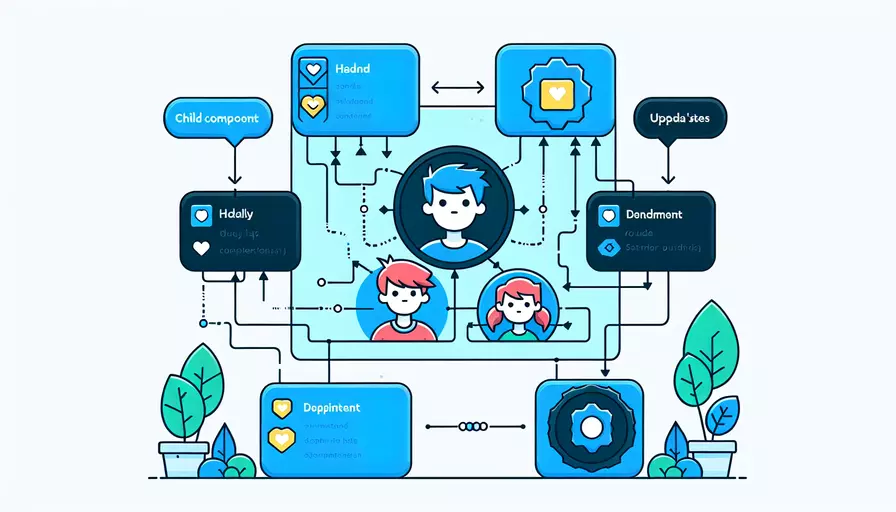
在Vue父组件中更新子组件的方法有多种,主要包括以下几种:1、通过Props传递数据,2、使用事件通信,3、通过Ref直接操作子组件,4、使用Vuex或其他状态管理工具。我们可以通过Props传递数据这一方法来详细解释如何更新子组件。
一、通过Props传递数据
当父组件的数据变化时,通过Props传递给子组件的数据也会随之更新,从而实现子组件的更新。这是最常用的方法,且符合Vue的单向数据流原则。
-
父组件中定义数据:
<template><div>
<child-component :data="parentData"></child-component>
<button @click="updateData">Update Data</button>
</div>
</template>
<script>
import ChildComponent from './ChildComponent.vue';
export default {
components: {
ChildComponent
},
data() {
return {
parentData: 'Initial Data'
};
},
methods: {
updateData() {
this.parentData = 'Updated Data';
}
}
};
</script>
-
子组件接收Props:
<template><div>
{{ data }}
</div>
</template>
<script>
export default {
props: ['data']
};
</script>
当用户点击按钮时,父组件中的parentData更新,子组件中的data也会自动更新。
二、使用事件通信
父组件可以通过监听子组件触发的事件来更新数据,进而通过Props传递更新后的数据给子组件。
-
子组件中触发事件:
<template><div>
<button @click="notifyParent">Notify Parent</button>
</div>
</template>
<script>
export default {
methods: {
notifyParent() {
this.$emit('update-data', 'New Data from Child');
}
}
};
</script>
-
父组件监听事件并更新数据:
<template><div>
<child-component @update-data="updateData"></child-component>
</div>
</template>
<script>
import ChildComponent from './ChildComponent.vue';
export default {
components: {
ChildComponent
},
data() {
return {
parentData: 'Initial Data'
};
},
methods: {
updateData(newData) {
this.parentData = newData;
}
}
};
</script>
三、通过Ref直接操作子组件
父组件可以通过ref获取子组件的实例,然后直接调用子组件的方法或修改子组件的数据。
-
子组件定义方法或数据:
<template><div>
{{ childData }}
</div>
</template>
<script>
export default {
data() {
return {
childData: 'Initial Child Data'
};
},
methods: {
updateChildData(newData) {
this.childData = newData;
}
}
};
</script>
-
父组件通过ref操作子组件:
<template><div>
<child-component ref="childRef"></child-component>
<button @click="updateChild">Update Child</button>
</div>
</template>
<script>
import ChildComponent from './ChildComponent.vue';
export default {
components: {
ChildComponent
},
methods: {
updateChild() {
this.$refs.childRef.updateChildData('Updated Child Data');
}
}
};
</script>
四、使用Vuex或其他状态管理工具
对于复杂的应用,使用Vuex或其他状态管理工具来管理全局状态,使父子组件共享状态更加方便和规范。
-
定义Vuex状态:
// store.jsimport Vue from 'vue';
import Vuex from 'vuex';
Vue.use(Vuex);
export default new Vuex.Store({
state: {
sharedData: 'Initial Shared Data'
},
mutations: {
updateData(state, newData) {
state.sharedData = newData;
}
}
});
-
父组件和子组件使用Vuex状态:
// ParentComponent.vue<template>
<div>
<child-component></child-component>
<button @click="updateData">Update Data</button>
</div>
</template>
<script>
import { mapState, mapMutations } from 'vuex';
import ChildComponent from './ChildComponent.vue';
export default {
components: {
ChildComponent
},
computed: {
...mapState(['sharedData'])
},
methods: {
...mapMutations(['updateData'])
}
};
</script>
// ChildComponent.vue<template>
<div>
{{ sharedData }}
</div>
</template>
<script>
import { mapState } from 'vuex';
export default {
computed: {
...mapState(['sharedData'])
}
};
</script>
通过这些方法,父组件可以有效地更新子组件的数据和状态。
总结:在Vue父组件中更新子组件的方法主要有通过Props传递数据、使用事件通信、通过Ref直接操作子组件、使用Vuex或其他状态管理工具。选择合适的方法可以根据具体的需求和项目的复杂度来决定。对于简单的场景,使用Props和事件通信是最常用的方法;对于复杂的场景,使用Vuex等状态管理工具可以提供更好的状态管理和维护性。
相关问答FAQs:
1. 子组件如何更新父组件中的数据?
在Vue中,父组件和子组件之间的通信是通过props和$emit实现的。如果子组件想要更新父组件中的数据,可以通过在子组件中使用$emit触发一个自定义事件,然后在父组件中监听该事件,并在对应的事件处理函数中更新数据。
例如,在父组件中定义一个名为message的数据,并将其传递给子组件作为props:
<template>
<div>
<p>{{ message }}</p>
<ChildComponent :message="message" @update-message="updateMessage"></ChildComponent>
</div>
</template>
<script>
import ChildComponent from './ChildComponent.vue';
export default {
components: {
ChildComponent
},
data() {
return {
message: 'Hello Vue!'
};
},
methods: {
updateMessage(newMessage) {
this.message = newMessage;
}
}
};
</script>
在子组件中,可以通过this.$emit触发update-message事件,并将新的消息作为参数传递:
<template>
<div>
<input v-model="newMessage" type="text">
<button @click="updateParentMessage">Update Parent</button>
</div>
</template>
<script>
export default {
data() {
return {
newMessage: ''
};
},
methods: {
updateParentMessage() {
this.$emit('update-message', this.newMessage);
}
}
};
</script>
当点击子组件中的按钮时,会触发updateParentMessage方法,该方法会通过this.$emit('update-message', this.newMessage)触发update-message事件并传递新的消息。父组件中的updateMessage方法会被调用,将新的消息更新到父组件的message数据中,从而实现了子组件更新父组件的数据。
2. 子组件如何实时更新父组件中的数据?
有时候,我们希望子组件能够实时更新父组件中的数据,而不仅仅是在特定的事件触发时更新。为了实现这个功能,可以使用Vue的.sync修饰符。
在父组件中,可以使用.sync修饰符将一个prop的更新传递给子组件,并且在子组件中可以通过修改一个名为update:propName的事件来实现实时更新父组件的数据。
例如,在父组件中定义一个名为message的数据,并将其传递给子组件作为props:
<template>
<div>
<p>{{ message }}</p>
<ChildComponent :message.sync="message"></ChildComponent>
</div>
</template>
<script>
import ChildComponent from './ChildComponent.vue';
export default {
components: {
ChildComponent
},
data() {
return {
message: 'Hello Vue!'
};
}
};
</script>
在子组件中,可以直接修改message的值,并触发update:message事件,从而实时更新父组件中的数据:
<template>
<div>
<input v-model="message" type="text">
</div>
</template>
<script>
export default {
props: ['message'],
methods: {
updateParentMessage() {
this.$emit('update:message', this.message);
}
},
watch: {
message(newMessage) {
this.$emit('update:message', newMessage);
}
}
};
</script>
当在子组件中修改输入框的值时,会触发message的更新,并通过this.$emit('update:message', this.message)实时更新父组件中的数据。
3. 子组件如何更新其他子组件中的数据?
在Vue中,子组件之间的通信可以通过父组件作为中间人来实现。如果一个子组件想要更新其他子组件中的数据,可以通过父组件的props和事件来实现。
例如,假设有两个子组件:ChildComponent1和ChildComponent2,它们都被包含在一个父组件中。ChildComponent1想要更新ChildComponent2中的数据。
在父组件中,定义一个名为dataToBeUpdated的数据,并将其作为props传递给ChildComponent1和ChildComponent2:
<template>
<div>
<ChildComponent1 :data-to-be-updated="dataToBeUpdated"></ChildComponent1>
<ChildComponent2 :data-to-be-updated="dataToBeUpdated"></ChildComponent2>
</div>
</template>
<script>
import ChildComponent1 from './ChildComponent1.vue';
import ChildComponent2 from './ChildComponent2.vue';
export default {
components: {
ChildComponent1,
ChildComponent2
},
data() {
return {
dataToBeUpdated: ''
};
}
};
</script>
在ChildComponent1中,可以通过修改dataToBeUpdated的值来更新数据,并通过$emit触发一个自定义事件来通知父组件数据已经更新:
<template>
<div>
<input v-model="dataToBeUpdated" type="text">
<button @click="updateData">Update</button>
</div>
</template>
<script>
export default {
props: ['dataToBeUpdated'],
methods: {
updateData() {
// 更新数据
this.dataToBeUpdated = 'New Data';
// 触发自定义事件
this.$emit('data-updated', this.dataToBeUpdated);
}
}
};
</script>
在ChildComponent2中,可以通过监听父组件传递过来的data-to-be-updated属性,并在父组件中的data-updated事件被触发时更新数据:
<template>
<div>
<p>{{ dataToBeUpdated }}</p>
</div>
</template>
<script>
export default {
props: ['dataToBeUpdated'],
created() {
// 监听属性变化
this.$watch('dataToBeUpdated', (newValue) => {
// 更新数据
this.dataToBeUpdated = newValue;
});
}
};
</script>
当在ChildComponent1中点击按钮时,会通过this.$emit('data-updated', this.dataToBeUpdated)触发data-updated事件,并将新的数据传递给父组件。父组件中的dataToBeUpdated会被更新,从而触发ChildComponent2中的watch监听函数,实时更新ChildComponent2中的数据。
文章标题:vue父组件中子组件如何更新,发布者:飞飞,转载请注明出处:https://worktile.com/kb/p/3686839

 微信扫一扫
微信扫一扫  支付宝扫一扫
支付宝扫一扫 